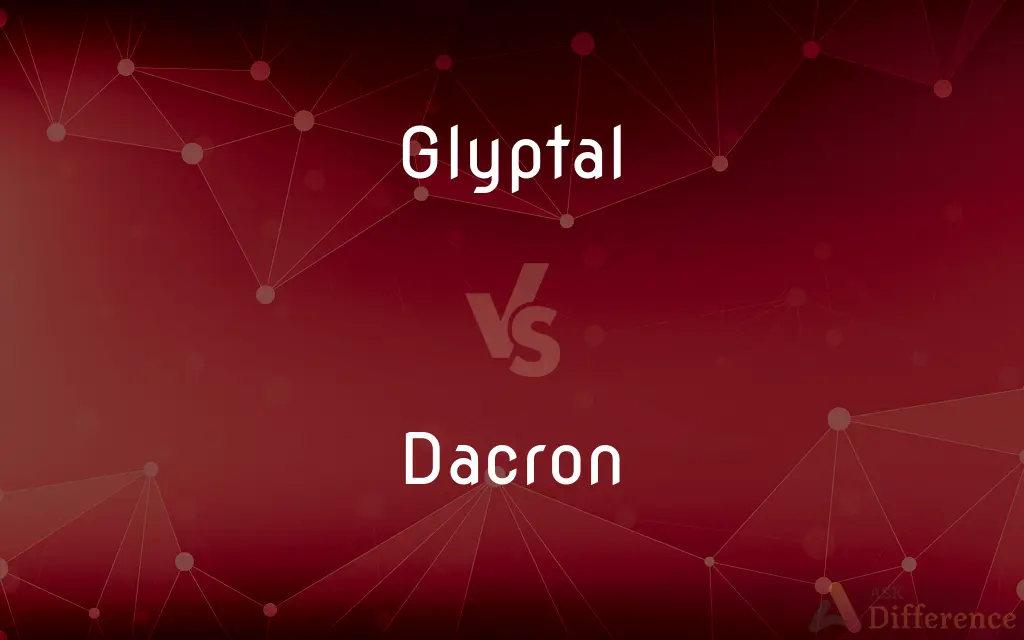Glyptal vs. Dacron — What's the Difference?
By Tayyaba Rehman — Updated on September 28, 2023
Glyptal is a resin used as an insulating varnish for electrical equipment; Dacron is a polyester fiber used in textiles and fabric. Both are synthetic but serve different purposes.

Difference Between Glyptal and Dacron
Table of Contents
ADVERTISEMENT
Key Differences
Glyptal and Dacron, while both synthetic materials, serve distinct purposes in varied industries. Glyptal is renowned for its use as an insulating varnish, predominantly within the electrical equipment sector. It is a type of alkyd resin created by polymerizing glycerol and phthalic acid, designed to protect and insulate electrical components. Glyptal is highly valued for its insulating properties, resistance to heat, and its ability to prevent corrosion, ensuring longevity and reliability of electrical systems.
In contrast, Dacron is a brand name for a type of polyester fiber, polyethylene terephthalate (PET), extensively utilized in the textile industry. Dacron is renowned for its durability, resistance to chemicals and mildew, and its ability to dry quickly, making it a preferred choice for clothing, especially sportswear, and outdoor equipment. It is lightweight and resilient, allowing for comfort and versatility in various textile applications, from apparel to home furnishings.
Though Glyptal and Dacron are synthetically manufactured, their composition, applications, and industries they serve differ significantly. Glyptal is integral for ensuring the safety and efficacy of electrical components, offering protective insulation in applications like transformers and motors. Dacron, on the other hand, is omnipresent in textiles, offering durability and comfort in the creation of fabrics for myriad uses, highlighting the versatility of synthetic materials in catering to diverse needs.
The comprehensive understanding of the differences between Glyptal and Dacron is crucial, as it underlines the versatility and innovation in synthetic material technology. Recognizing Glyptal as a protective insulating resin and Dacron as a versatile polyester fiber enables informed choices in electrical equipment maintenance and textile selection, respectively, allowing for optimization of material properties in diverse applications.
Comparison Chart
Composition
Alkyd resin, polymer of glycerol and phthalic acid.
Polyester fiber, polyethylene terephthalate (PET).
ADVERTISEMENT
Primary Use
Insulating varnish for electrical equipment.
Textiles and fabric, especially in clothing and furnishings.
Properties
Heat resistant, prevents corrosion, insulative.
Durable, chemical-resistant, quick-drying, mildew-resistant.
Industries Served
Electrical and electronics industry.
Textile industry.
Application Example
Used in transformers and motors for insulation.
Used in sportswear, outdoor equipment, and home furnishings.
Compare with Definitions
Glyptal
A synthetic resin used primarily as an insulating varnish in electrical equipment.
Glyptal is applied to the windings of motors to provide electrical insulation.
Dacron
A brand of polyester fiber used extensively in textiles and fabrics.
Dacron is a popular choice for making durable and lightweight clothing.
Glyptal
Used to protect electrical components from environmental factors and corrosion.
Applying Glyptal enhances the longevity and reliability of transformers by offering protection against external elements.
Dacron
Represents polyethylene terephthalate (PET) in the textile industry.
Dacron, being a form of PET, is widely recognized in the textile sector for its versatile applications.
Glyptal
Predominantly serves the electrical and electronics industry.
The electrical industry values Glyptal for its ability to offer superior insulation in various applications.
Dacron
Utilized in a variety of textile applications, from clothing to home furnishings.
Many home furnishings like curtains and sofas utilize Dacron for its durability and aesthetic appeal.
Glyptal
An alkyd resin formed by the polymerization of glycerol and phthalic acid.
The chemical structure of Glyptal allows it to effectively prevent corrosion in electrical components.
Dacron
Offers comfort and versatility in textile products.
Sportswear often features Dacron due to its comfort and adaptability.
Glyptal
Known for its heat resistance and insulative properties.
The use of Glyptal ensures that electrical components can operate safely at high temperatures.
Dacron
Known for its durability, chemical resistance, and ability to dry quickly.
Dacron fabrics are preferred for outdoor equipment due to their resilience and resistance to mildew.
Glyptal
A resin, made from glycerol and phthalic anhydride (or similar), used in paints
Dacron
A polymer, polyethylene terephthalate PET, as used for making thread and cloth.
Dacron
A brand of polyester textile fiber, or the wrinkle-resistant fabric prepared from it.
Dacron
A kind of polyester fabric
Common Curiosities
Can Glyptal be used to make fabrics?
No, Glyptal is not suitable for making fabrics; it is used for insulating electrical components.
Is Glyptal a brand name like Dacron?
No, Glyptal is not a brand name; it refers to a specific type of alkyd resin, whereas Dacron is a brand name for a type of polyester fiber.
Is Glyptal suitable for making clothing?
No, Glyptal is unsuitable for making clothing; it is used as an insulating varnish in electrical equipment.
Is Glyptal used in the textile industry like Dacron?
No, Glyptal is primarily used as an insulating varnish in electrical equipment, not in textiles like Dacron.
Is Dacron used for insulating electrical components?
No, Dacron is not used for insulation in electrical components; it is primarily used in textiles and fabrics.
Is Dacron a type of resin like Glyptal?
No, Dacron is a polyester fiber used in textiles, unlike Glyptal, which is a type of resin.
Can Dacron resist corrosion like Glyptal?
Dacron is not typically used in contexts where corrosion resistance is a primary concern, as it is a textile material, unlike Glyptal, which is used to prevent corrosion in electrical components.
Can Dacron be used to protect electrical components?
Dacron is not used to protect electrical components; its primary applications are in textiles and fabrics.
Are Glyptal and Dacron composed of the same materials?
No, Glyptal is an alkyd resin, and Dacron is a polyester fiber; they have different compositions and applications.
Share Your Discovery

Previous Comparison
Faucet vs. Valve
Next Comparison
Tubercule vs. TubercleAuthor Spotlight
Written by
Tayyaba RehmanTayyaba Rehman is a distinguished writer, currently serving as a primary contributor to askdifference.com. As a researcher in semantics and etymology, Tayyaba's passion for the complexity of languages and their distinctions has found a perfect home on the platform. Tayyaba delves into the intricacies of language, distinguishing between commonly confused words and phrases, thereby providing clarity for readers worldwide.














































